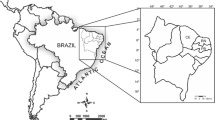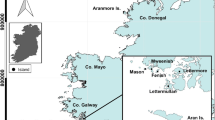Abstract
Chile is an important producer of brown seaweeds representing 10% of world supply. Landings of Chilean kelp fluctuated between 40,000 t.year−1 in the early ‘80s to 250,000 t.year−1 more recently. Commercialized algae come from natural populations and no mass-cultures of involved species have been established. Four species of brown algae are commercially collected in the country: Lessonia trabeculata, L. nigrescens, Macrocystis pyrifera and M. integrifolia. Since 2000, the demand of alginate sources and food for cultivated abalones dramatically raised the harvesting of these species. Direct evaluations of Lessonia spp. and Macrocystis standing-stocks were made along 700 km of coast in northern Chile. Lessonia spp. estimated populations exceed 900,000 t, whereas M. integrifolia does not exceed 300 t. The insights provided indicate that sustainability of Chilean kelp subjected to intense harvesting would require management programs including the following bio-ecological recommendations: (1) to harvest the entire plant including the holdfast; (2) to harvest plants larger than 20 cm in diameter; (3) to harvest plants sparsely, selecting mayor specimens; (4) rotation of harvesting areas; and (5) for Macrocystis, to cut the canopy 1–2 m from the surface. They must be implemented in a National Program of Kelp Management, elaborated by government, scientists, fisherman, and industry.







Similar content being viewed by others
References
Anderson RJ, Rothman MD, Share A, Drummond H (2006) Harvesting of the kelp Ecklonia maxima in South Africa affects its three obligate, red algal epiphytes. J Appl Phycol 18:343–349
Anuario Estadístico de Pesca (1985–2006) Servicio Nacional de Pesca, Ministerio de Economía Fomento y Reconstrucción, Gobierno de Chile
Avila M, Seguel M (1993) An overview of seaweed resources in Chile. J Appl Phycol 5:133–139
Barilotti DC, Zertuche-González JA (1990) Ecological effects of seaweed harvesting in the Gulf of California and Pacific Ocean off Baja California and California. Hydrobiologia 204/205:35–40
Bernal P, Oliva D, Aliaga B, Morales C (1999) New regulations in Chilean fisheries and aquaculture: ITQ’s and territorial user rights. Ocean Coast Manag 42:119–142
Burrough PA, Mcdonell RA (1998) Principles of geoghraphic information systems, spatial information and geostatistics. Oxford University Press, Oxford, p 333
Buschmann AH, Vásquez, Osorio P, Reyes E, Filún L, Hernandez-González M, Vega AML (2004) The effect of water movement, temperatura and salinity on abundante and reproductive patterns of Macrocystis spp (Phaeophyta) at different latitudes. Mar Biol 145:849–862
Buschmann AH, Moreno C, Vásquez JA, Hernandez-Carmona MC (2006) Reproduction strategies of Macrocystis pyrifera (Phaeophyta) in southern Chile: the importance of population dynamics. J Appl Phycol 18:575–582
Cancino J, Santelices B (1984) Importancia ecológica de los discos adhesivos de Lessonia nigrescens Bory (Phaeophyta) en Chile central. Rev Chil Hist Nat 56:23–33
Dayton PK (1972) Toward an understanding of community resilience and the potential effects of enrichments to the benthos at McMurdo Sound, Antarctica. In: Parker BC (ed) Proceedings of the Colloquium on Conservation Problems in Antarctica. Allen Press, Virginia, pp 81–95
Dayton PK, Currie V, Gerrodette T, Keller BD, Rosenthal R, Vantresca D (1984) Patch dynamic and stability of some Californian kelp communities. Ecol Monogr 54:253–289
Edding M, Fonck E, Macchiavello J (1994) Lessonia. In: Akatsuka I (ed) Biology of economic algae. SPB Publishing, The Hague, pp 407–446
Gelcich S, Edwards-Jones G, Kaiser MJ, Watson E (2005a) Using discourses for policy evaluation: the case of marine common property rights in Chile. Soc Nat Res 18:377–391
Gelcich S, Edwards-Jones G, Kaiser MJ (2005b) Importance of attitudinal differences among artisanal fishers towards co-management and conservation of marine resources. Conserv Biol 19:865–875
Graham MH, Vásquez JA, Buschmann AH (2007) Global ecology of the giant kelp Macrocystis: from ecotypes to ecosystems. Ocean Mar Biol Ann Rev 45:39–88
Guillaumont B, Callens L, Dion P (1993) Spatial distribution of Fucus species and Ascophyllum nodosum beds in intertidal zones using spot imagery. Hydrobiologia 260/261:297–305
Gutierrez A, Correa T, Muñoz V, Santibañez A, Marcos R, Cáceres C, Buschmann AH (2006) Farming of the giant kelp Macrocystis pyrifera in southern Chile for development of novel food products. J Appl Phycol 18:259–267
Harrold C, Pearse JS (1987) The ecological role of echinoderms in kelp forests. In: Jangoux M, Lawrence JM (eds) Echinoderm studies, vol 2. Balkema, Rotterdam, pp 137–233
Hoffmann AJ, Santelices B (1997) Marine Flora of Central Chile. Ediciones Universidad Católica de Chile, Santiago, 434 pp
Jones CG, Lawton H, Shachak M (1994) Organisms as ecosystem engineers. Oikos 69, 373–386
Klopatek JM, Francis JM (1999) Spatial patterns analysis techniques. In: S Morain (ed) GIS Solutions in natural resource management: Balancing the technical-political equation. OnWord, Independence, KY, pp 17–40
Mendieta JJ (1997) Consideraciones ecológicas para el manejo de poblaciones de Lessonia trabeculata Villouta & Santelices (1986) en el norte de Chile. Tesis para optar al grado académico de Magister en Ciencias del Mar. Fac. Cs. del Mar, Universidad Católica del Norte, Coquimbo, Chile, 80 pp
Muñoz V, Hernández-González MC, Buschmann AH, Graham MH, Vásquez JA (2004) Variability in per capita oogonia and sporophyte production from giant kelp gametophyte (Macrocystis pyrifera, Phaeophyceae). Rev Chil Hist Nat 77:639–647
Ostrom E, Schlager E (1996) The formation of property rights. In: Hanna S, Folke C, Maler K (eds) Rights to nature: ecological, economic, cultural and political principals of institutions for the environment. Island Press, Washington, pp 127–157
Santelices B (1989) Algas Marinas de Chile. Distribución, Ecología Utilización y Diversidad. Ediciones Universidad Católica de Chile, Santiago de Chile, 399 pp
Santelices B, Doty MS (1989) A review of Gracilaria farming. Aquaculture 78:95–133
Shiel DR, Nelson W (1990) The harvesting of macroalgae in New Zealand. Hydrobiologia 204/205:25–33
Sjotun K, Fredriksen S, Lein TE, Rueness J, Sivertsen K (1993) Population studies of Laminaria hyperborea in northern range of distribution in Norway. Hydrobiologia 260/261:215–221
Stekoll MS, Deysher LE, Hess M (2006) A remote sensing approach to estimating harvestable kelp biomass. J Appl Phycol 18:323–334
Rothman MD, Anderson RJ, Smit AJ (2006) The effects of harvesting of the South African kelp (Ecklonia maxima) on the kelp population structure, growth rate and recruitment. J Appl Phycol 18:335–341
Terawaki T, Hasegawa H, Arai S, Ohno M (2001) Management-free techniques for restoration of Eisenia and Ecklonia beds along the central Pacific coast of Japan. J Appl Phycol 13:13–17
Ugarte RA, Sharp G (2001) A new approach to seaweed management in Easter Canada: the case of Ascophyllum nodosum. Cah Biol Mar 42:63–70
Ugarte RA, Sharp G, Moore B (2006) Changes in the brown seaweed Ascophyllum nodosum (L.) Le Jol. Plant morphology and biomass produced by cutter rake harvest in southern New Brunswick, Canada. J Appl Phycol 18:351–359
Vásquez JA (1992) Lessonia trabeculata, a subtidal bottom kelp in northern Chile: a case of study for a structural and geographical comparison. In: Seeliger U (ed) Coastal plant communities of latin america. Academic Press, San Diego, pp 77–89
Vásquez JA (1993) Patrones de distribución de poblaciones submareales de Lessonia trabeculata (Laminariales, Phaeophyta) en el norte de Chile. SERIE OCASIONAL Facultad de Ciencias del Mar, Universidad Católica del Norte 2, pp 187–211
Vásquez JA, Fonck E (1993) Algas productoras de ácido algínico en Sudamérica: diagnóstico y proyecciones. In: Documento de Campo No 13 Situación actual de la industria de macroalgas productoras de ficocoloides en América Latina y el Caribe. FAO- ITALIA. Programa Cooperativo Gubernamental, pp 17–26
Vásquez JA, Santelices B (1984) Comunidades de macroinvertebrados en discos de adhesión de Lessonia nigrescens en Chile central. Rev Chil Hist Nat 57:131–154
Vásquez JA, Santelices B (1990) Ecological effects of harvesting Lessonia (Laminariales, Phaeophyta) in central Chile. Hydrobiologia 204/205:41–47
Vásquez JA, Vega JMA (2005). Macroinvertebrados asociados a discos de adhesión de algas pardas: Biodiversidad de comunidades discretas como indicadoras de perturbaciones locales y de gran escala. In: Figueroa E (ed) Biodiversidad Marina: Valoración, usos y perspectivas ¿Hacia donde va Chile? Editorial Universitaria Santiago-Chile, pp 429–450
Vásquez JA, Westermeier R (1993) Limiting factors in optimizing seaweed yield in Chile. Hydrobiologia 260/261:180–187
Vásquez JA, Véliz D, Pardo LM ( 2001) Biodiversidad bajo las grandes algas. In: Alveal K, Antezana T (eds) Sustentabilidad de la biosiversidad. Un problema actual, bases científico-técnicas, teorizaciones y perspectivas. Universidad de Concepción-Concepción, pp 293–308
Vásquez JA, Vega JMA, Buschmann AH (2006) Long term studies on El Niño-La Niña in northern Chile: effects on the structure and organization of subtidal kelp assemblages. J Appl Phycol 18:505–519
Vega JMA, Vásquez JA, Buschmann AH (2005) Biology of the subtidal kelps Macrocystis integrifolia and Lessonia trabeculata (Laminariales, Phaeophyceae) in an upwelling ecosystem of northern Chile: interannual variability and El Niño 1997–98. Rev Chil Hist Nat 78:33–50
Venegas M, Tala F, Fonck E, Vásquez JA (1992) Sporangial sori on stipes of Lessonia nigrescens Bory (Laminariaceae, Phaeophyta): a high frecuency phenomenom in intertidal populations of northern Chile. Bot Mar 35:573–578
Villouta E, Santelices B (1984) Estructura de la comunidad submareal de Lessonia (Phaeophyta, Laminariales) en Chile norte y central. Rev Chil Hist Nat 57:111–122
Villouta E, Santelices B (1986) Lessonia trabeculata sp. Nov. (Laminariales: Phaeophyta), a new kelp from Chile. Phycologia 25:81–86
Werner A, Kraan S (2004) Review of the potential mechanization of kelp harvesting in Ireland. Mar Envir Health Ser 17:1–52
Westermeier R, Patiño D, Piel MI, Maier I, Mueller DG (2006) A new approach to kelp mariculture in Chile: production of free-floating sporophyte seedlings from gametophyte cultures of Lessonia trabeculata and Macrocystis pyrifera. Aquacult Res 37:164–171
Zemcke-White WL, Ohno M (1999) World seaweed utilization: An end-of-century summary. J Appl Phycol 11:369–376
Acknowledgements
O. Castillo, R. Rojas, G. Vásquez, G. Aguirre, N. Kusmicic, E. Montanares, J. Johnson for their valuable work in the field. COPRAM Marine Seaweed Producers-Chile and Abalone Association-Chile.
Author information
Authors and Affiliations
Corresponding author
Rights and permissions
About this article
Cite this article
Vásquez, J.A. Production, use and fate of Chilean brown seaweeds: re-sources for a sustainable fishery. J Appl Phycol 20, 457–467 (2008). https://doi.org/10.1007/s10811-007-9308-y
Received:
Revised:
Accepted:
Published:
Issue Date:
DOI: https://doi.org/10.1007/s10811-007-9308-y




